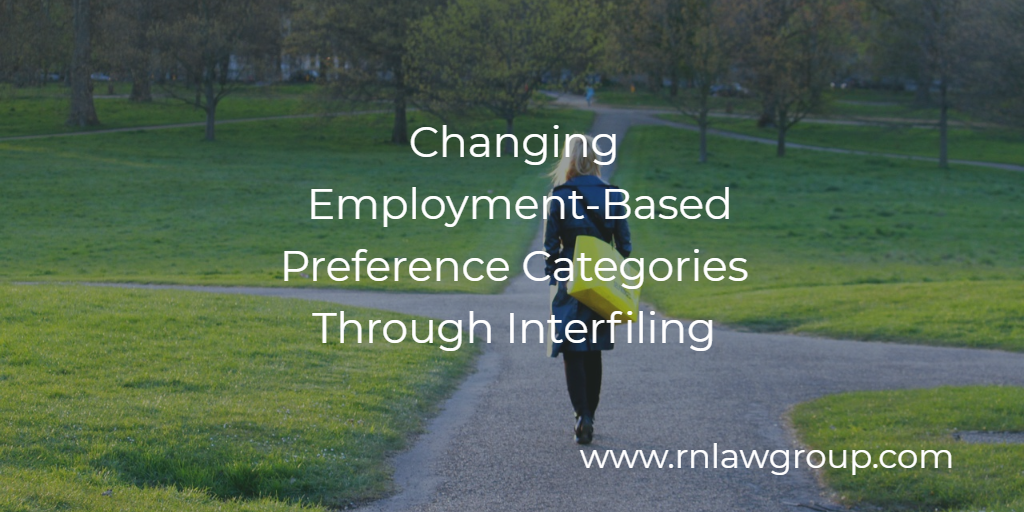
Changing Preference Categories Through Interfiling
The USCIS Policy Manual provides that an adjustment of status applicant whose application is based on one immigrant category may have the pending application considered under a different category. The underlying petition could be any type: I-360, I-130, I-526, or I-140, but most commonly it is an I-140 or I-130 petition. The desire to change preference categories has most recently come about due to the flip-flopping of EB-2 and EB-3 cut-off dates in the Visa Bulletin for those born in India.
The major advantage of interfiling is that there is no need to re-pay any of the filing fees, or redo any of the application forms. While interfiling is technically an option, it does not always work.
As a practical matter, it is very difficult for USCIS Service Centers to accommodate the interfiling of a different I-140 into a pending I-485 file. Interfiling is not something authorized by statute or regulations; rather, it was simply noted in an Immigration and Naturalization Service (INS) memo from 2000 and remains an ad hoc process.
In lieu of interfiling, it may be more practical, albeit more expensive, to file a new I-485 application with the I-140 approval from a different preference category. A new filing has the advantage of avoiding the challenges of coordinating an interfile request with USCIS, and may be particularly useful if it is hard to predict which preference category will be current in the coming months. Whether or not filing a new I-485 application is worth the additional expense and effort is only part of the analysis. It is also important to check that it is, in fact, an option. If an adjustment of status applicant has not maintained his or her underlying nonimmigrant status, they may not be eligible to file a new I-485.
Who Qualifies for Interfiling to Change Preference Categories?
- There must be no break in the continuity of the applicant’s underlying eligibility to adjust from the date the I-485 application was filed until the date USCIS receives the transfer request.
- I-485 applications based on petitions determined to have been filed fraudulently or with willful misrepresentation cannot be transferred.
- There must be no break in the continuity of the pending I-485 application, such as a withdrawal or denial for an unjustified failure to appear at scheduled interview or where a final decision has been made, even if USCIS subsequently reopens or reconsiders the final decision.
- The applicant must provide evidence of eligibility for the new immigrant category in support of the request to transfer, usually the I-140 approval notice.
- The priority date for the new preference category must be current on the date the transfer request is made. Note that the USCIS guidance was written before USCIS accepted I-485 applications based on the “Dates for Filing” charts, so the interfile request can only be made when the Visa Bulletin final action date is current for the I-140 approval in the other category.
- USCIS’s decision to grant or deny a transfer request is discretionary: The majority of interfiling involves transfers between the first three employment-based categories, and tend to be granted. Requests that involve jurisdiction constraints or difficulties, or that may greatly lengthen the processing time of the adjustment application, may result in the request being denied. In exercising their discretion, officers may consider the reason(s) for the request, the effects of additional processing time required to gather evidence to support the applicant’s new claim, the availability or unavailability of documentation to support the new claim, the degree of difficulty in obtaining needed receipt files from other USCIS offices, the degree of difficulty in determining the applicant’s continued eligibility from the first underlying petition, and the extent of processing steps already taken on the adjustment application.
How is Interfiling Accomplished?
USCIS does not have a specific process for requesting a pending adjustment of status application be transferred to a different preference category, so it can be something of a “hit or miss” effort. There are a number of potential options to request a change of preference category for a pending I-485.
- Calling the USCIS Contact Center
- Chatting with “Emma”
- Sending a written request
- Making an inquiry with a member of Congress
- At the time of interview
Other Points to Be Aware Of
- Only one petition may form the basis of an adjustment application at any given time. The applicant must clearly designate in writing which petition should serve as the new basis.
- If a transfer request is granted, the original petition will no longer support the adjustment application. Keep this rule in mind if the priority dates may move back and forth. You may end up “chasing your tail” if you interfile and the Visa Bulletin changes again. If the transfer request is granted, the applicant is not permitted to withdraw the request.
- If an employment-based applicant requests to transfer the adjustment application to a different employment-based category, the applicant may not utilize the portability provisions of AC-21 until 180 days or more after making the transfer request.
By: Emily Neumann, Managing Partner
Emily Neumann practices immigration law at Reddy Neumann Brown PC, Houston’s largest immigration law firm focused solely on U.S. employment-based immigration. Since 2005, she has partnered with HR professionals to help their businesses secure work authorization for their valued foreign national employees, including F-1 students. She has been named a “Top 10 Immigration Law Attorney” and received a “10 Best” Award for Client Satisfaction. Emily has been quoted in Bloomberg Law, U.S. News & World Report, Inside Higher Ed, and The Times of India on various hot topics in immigration. She is a member of the American Immigration Lawyers Association and Society for Human Resource Management.

